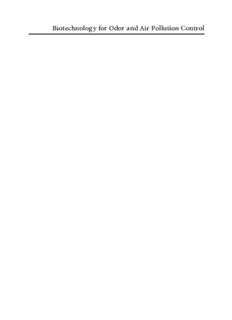
Biotechnology for Odor and Air Pollution Control PDF
Preview Biotechnology for Odor and Air Pollution Control
Biotechnology for Odor and Air Pollution Control Zarook Shareefdeen • Ajay Singh (Eds.) Biotechnology for Odor and Air Pollution Control With 70 Figures 123 DR.ZAROOKSHAREEFDEEN DR.AJAYSINGH BIOREM Technologies Inc. Petrozyme Technologies Inc. Research and Development 7496 Wellington Road 34 7496 Wellington Road 34 Guelph,ON N1H 6H9 Guelph,ON N1H 6H9 Canada Canada Department ofBiology e-mail: University ofWaterloo [email protected] Waterloo,ON N2L 3G1 Canada e-mail: [email protected] [email protected] Library ofCongress Control Number:2004112254 ISBN 3-540-23312-1 Springer Berlin Heidelberg New York This work is subject to copyright.All rights reserved,whether the whole or part of the material is concerned,specifically the rights of translation,reprinting,reuse of illustra- tions,recitation,broadcasting,reproduction on microfilm or in any other way,and stora- ge in data banks.Duplication ofthis publication or parts thereofis permitted only under the provisions ofthe German Copyright Law ofSeptember 9,1965,in its current version, and permission for use must always be obtained from Springer.Violations are liable for prosecution under the German Copyright Law. Springer is a part ofSpringer Science + Business Media springeronline.com © Springer-Verlag Berlin Heidelberg 2005 Printed in Germany The use of general descriptive names,registered names,trademarks,etc.in this publica- tion does not imply,even in the absence of a specific statement,that such names are exempt from the relevant protective laws and regulations and therefore free for general use. Cover design:design & production,Heidelberg,Germany Typesetting and production:LE-TeX Jelonek,Schmidt & Vöckler GbR,Leipzig,Germany 31/3150 YL - 5 4 3 2 1 0 - Printed on acid-free paper Preface Volatile organic and inorganic odorous compounds from various industries areemittedinlargequantitiesandcreatehazardstotheecosystemandhealth effectstohumans.Theneedforodorandairpollutioncontrolisdrivenbyreg- ulatoryissues,generallyenforcedasaresultofpubliccomplaintsaboutpoor localairqualityandthroughemissionmonitoringbytheenforcementagen- cies.Withincreasingpopulations,andnewresidentialandindustrialdevelop- ments,thedemandforairpollutioncontrolsystemsthatprovidenuisance-free, breathableairisgrowing. Biotechnologyoffersoneofthemosteconomicalandenvironmentallybe- nignmethodsofairpollutioncontrolforindustrialandmunicipalairstreams. Bioprocess is becoming an effective alternative to traditional physical and chemicalodorremovalmethodsusedinwastewatertreatmentplants,render- ingplants,chemicalproductionfacilities,andfoodandflavormanufacturing facilities. This book, Biotechnology for Odor and Air Pollution Control, covers not onlythebasicmicrobiologicalandengineeringaspectsofvariousbioreactors, but also describes the design, modeling, and control of such bioreactors for theiruniqueapplicationsinodorandairpollutionmanagement,andcontrol inindustrialfacilitiesandwastewatertreatmentplants.Specifictopicsinclude methods of odor and volatile organic compound (VOC) control, regulatory issues, microbiological aspects of bioreactors, selection of bioreactor media, descriptionanddesignofvariousbioreactorsforodorandairpollutioncontrol, suchasbiofilter,biotricklingfilter,bioscrubberandmembranebioreactor,and applicationsandcasestudiesrelatedtothesetechnologiesforthetreatmentof aircontaminantsinmunicipalandindustrialplants,andfutureprospectsof biotechnologyforodorandairpollutioncontrol. The contributing authors are applied and industrial researchers from di- versebackgrounds:universities,researchinstitutes,andindustries.Theyare experts in biological methods for odor and air pollution control. This book will be a valuable reference tool for graduate students, scientists, industrial consultants,biotechnologists,microbiologists,andchemical,biochemical,en- vironmentalandcivilengineerswhoareinterestedinenvironmentalsciences, andparticularly,ininnovativebiologicaltechnologiesfortreatmentandcon- trolofodorandairpollution.Wehopethatstudents,teachers,scientistsand engineers,whetherinacademia,industryorgovernment,willfindthedescrip- tiveandpracticalcontentsofthisbookinterestingandhelpful. VI Preface We are grateful to all the authors for their excellent contributions. Sev- eral of our colleagues provided encouragement and help during the various stages of this editorial work. Continuous support and guidance provided by Dr.JuttaLindenborn,Springer,duringthepreparationofthisbookishighly appreciated. Guelph,Ontario,May2004 ZarookShareefdeenandAjaySingh Contents PartI IntroductionandBasicTheory 1 BiotechnologyforAirPollutionControl–anOverview ZarookShareefdeen,BrianHerner,AjaySingh................ 3 1.1 Introduction....................................................................... 3 1.2 MethodsofOdorandVOCControl........................................ 3 1.3 BiologicalReactors.............................................................. 4 1.3.1 BioreactorMedia..................................................... 4 1.3.2 Microbiology.......................................................... 5 1.3.3 TypesofBioreactors................................................. 7 1.4 ModelingandDesignofBioreactors....................................... 8 1.4.1 ModelingofBioreactors............................................ 8 1.4.2 DesignofBioreactors............................................... 9 1.5 TypesofContaminants ........................................................ 10 1.6 CaseStudies....................................................................... 11 1.7 Conclusion......................................................................... 12 References.................................................................................. 12 2 EnvironmentalLawsandRegulationsRelatedtoOdor andWasteGasContaminants RodneyL.Aldrich.................................................. 17 2.1 Introduction....................................................................... 17 2.2 ControlofVOCs.................................................................. 18 2.3 ControlofOdor-CausingChemicals....................................... 20 2.4 BriefOverviewofOdorRestrictionsAroundtheWorld ............ 21 2.4.1 TheUnitedStatesofAmerica .................................... 21 2.4.2 Japan..................................................................... 24 2.4.3 China..................................................................... 24 2.4.4 TheUnitedKingdom................................................ 24 2.4.5 Canada................................................................... 25 2.5 Conclusions........................................................................ 26 References.................................................................................. 28 VIII Contents 3 MethodsofOdorandVOCControl SergioRevah,JuanM.Morgan-Sagastume....................... 29 3.1 VOCsandOdorDefinition ................................................... 29 3.2 MethodsforVOCsandOdorControl..................................... 30 3.3 Physical-chemicalMethods................................................... 35 3.3.1 Dilution ................................................................. 35 3.3.2 Condensation.......................................................... 35 3.3.3 Membranes............................................................. 36 3.3.4 UVOxidation.......................................................... 36 3.3.5 Plasma................................................................... 37 3.3.6 Adsorption............................................................. 38 3.3.7 Combustion(Flares,ThermalandCatalyticIncinerators) 38 3.3.8 Masking................................................................. 40 3.3.9 CausticScrubbing.................................................... 40 3.3.10 RegenerativeGasScrubbing...................................... 41 3.3.11 ChemicalPrecipitation............................................. 42 3.3.12 ChlorineOxidation.................................................. 42 3.3.13 OzoneOxidation ..................................................... 42 3.3.14 PotassiumPermanganateOxidation........................... 42 3.3.15 CatalyticOxidationwithFe3+(LO-CATProcess).......... 43 3.3.16 HydrogenPeroxideOxidation.................................... 43 3.3.17 OxidationwithFeO.................................................. 43 3.4 BiologicalMethods.............................................................. 43 3.4.1 Terminology........................................................... 45 3.4.2 Mechanisms............................................................ 47 3.4.3 TheBiologicalPhase................................................ 48 3.5 TypesofBioreactors............................................................ 53 3.5.1 Biofilter.................................................................. 54 3.5.2 BiotricklingFilters................................................... 55 3.5.3 RotatingBiologicalContactors................................... 56 3.5.4 Bioscrubbers........................................................... 56 3.5.5 MembraneBioreactors............................................. 57 3.5.6 SuspendedCellBioreactor ........................................ 58 3.6 Conclusions........................................................................ 59 References.................................................................................. 60 4 SelectionofBioreactorMediaforOdorControl RakeshGovind,SandeepNarayan................................ 65 4.1 Introduction....................................................................... 65 4.2 DiffusiveVersusConvectiveMedia ........................................ 66 4.3 NaturallyBioactiveMedia .................................................... 68 4.4 SyntheticMedia.................................................................. 71 4.5 RandomlyPackedVersusStructuredBiomedia........................ 83 4.6 BiofilterVersusBiotricklingFilter.......................................... 85 Contents IX 4.7 ExperimentalStudiesonDiffusiveBiofilterMedia.................... 86 4.7.1 ExperimentalSetup.................................................. 86 4.7.2 AnalyticalProcedure................................................ 87 4.7.3 ResultsandDiscussion............................................. 88 4.8 ExperimentalStudiesonConvectiveBiofilterMedia................. 90 4.9 StudiesonEncapsulatedBiomassandMembraneBiofilters....... 92 4.10 Conclusions........................................................................ 94 Appendix................................................................................... 95 References.................................................................................. 99 5 MicrobiologyofBioreactorsforWasteGasTreatment AjaySingh,OwenWard............................................ 101 5.1 Introduction.......................................................................101 5.2 MicrobialCommunitiesInvolvedinWasteGasTreatment.........102 5.3 TheNatureofMicrobialBiofilms...........................................104 5.4 BiodegradationofAirPollutants ...........................................106 5.4.1 Biokinetics .............................................................106 5.4.2 BiodegradationofOrganicCompounds......................107 5.4.3 BiodegradationofInorganicCompounds....................108 5.5 FactorsAffectingMicrobialDegradationofAirContaminants...110 5.5.1 Bioavailability.........................................................110 5.5.2 Nutritional .............................................................111 5.5.3 Environmental........................................................113 5.6 GeneticApproachesforImprovedMicroorganisms..................114 5.7 MonitoringofMicrobialProcesses.........................................115 5.8 Conclusions........................................................................116 References..................................................................................116 PartII BiologicalReactorTechnologies 6 BiofilterTechnology IndraniDatta,D.GrantAllen....................................125 6.1 Introduction.......................................................................125 6.2 OverallProcessDescription..................................................125 6.3 BiofiltrationTerminology.....................................................126 6.3.1 EmptyBedResidenceTime.......................................127 6.3.2 Surface(orVolumetric)andMassLoadingRate...........127 6.4 MechanismofOperation......................................................128 6.4.1 TransferandPartitioningofContaminantstotheBiofilm128 6.4.2 Biodegradation .......................................................129 6.5 CharacterizingBiofilterPerformance.....................................129 6.5.1 RemovalEfficiency...................................................129 6.5.2 EliminationCapacity ...............................................130 6.5.3 MaximumEliminationCapacity................................130 X Contents 6.6 FactorsAffectingBiofilterPerformance..................................131 6.6.1 PackingMedia.........................................................131 6.6.2 MoistureContent.....................................................131 6.6.3 Temperature...........................................................132 6.6.4 OxygenContent.......................................................132 6.6.5 pH.........................................................................133 6.6.6 Nutrients................................................................133 6.6.7 PressureDrop.........................................................133 6.6.8 MediumDepth........................................................134 6.6.9 WasteGasPretreatment............................................135 6.6.10 Maintenance...........................................................135 6.7 MicrobiologyofBiofilters.....................................................135 6.8 AdvantagesandDisadvantages..............................................136 6.9 ApplicationsofBiofilters......................................................137 6.10 Conclusions........................................................................139 References..................................................................................140 7 BiotricklingFilterTechnology MarcA.Deshusses,DavidGabriel................................147 7.1 Introduction.......................................................................147 7.2 BiotricklingFilterDesignandOperation................................150 7.3 ConversionofChemicalScrubberstoBiotricklingFilters..........152 7.3.1 FirstApproachtotheConversion...............................153 7.3.2 GeneralProcedure toConvertFull-ScaleChemicalScrubbers...................155 7.3.3 H STreatment 2 ofConvertedChemicalScrubbersatOCSD..................161 7.4 Conclusions........................................................................166 References..................................................................................166 8 BioscrubberTechnology AjaySingh,ZarookShareefdeen,OwenP.Ward.................169 8.1 Introduction.......................................................................169 8.2 Bioscrubbers......................................................................170 8.3 BioscrubberDesign.............................................................173 8.3.1 MechanismforOdorousGasTreatmentbyBioscrubbers173 8.3.2 TheAbsorber..........................................................174 8.3.3 TheBioreactor ........................................................177 8.3.4 VariationsinBioscrubberDesigns..............................178 8.4 BioprocessControlinBioscrubbers.......................................180 8.4.1 Microbiology..........................................................180 8.4.2 Nutrients................................................................182 8.4.3 Oxygen ..................................................................182 8.4.4 pHandTemperature................................................183 8.4.5 SludgeAccumulationandDisposal.............................183 Contents XI 8.5 ApplicationofBioscrubbers..................................................184 8.5.1 WasteGasesfromWastewaterTreatmentPlant.............184 8.5.2 AerobicandAnaerobicGasTreatment........................187 8.5.3 TreatmentofFlueGases............................................187 8.5.4 TreatmentofWasteGasfromFishFeedFactory...........188 8.5.5 TreatmentofWasteGasContainingVOCs...................188 8.6 ConclusionandFutureDirections.........................................189 References..................................................................................190 9 MembraneBioreactorTechnology MarkW.Fitch...................................................... 195 9.1 Introduction.......................................................................195 9.2 MembraneBioreactorDesign................................................195 9.2.1 Mechanism.............................................................197 9.2.2 Membranes.............................................................198 9.2.3 Materials................................................................199 9.3 ReactorConfiguration..........................................................201 9.4 OperatingResults................................................................201 9.4.1 LoadingandEliminationCapacity.............................201 9.4.2 TransientLoadsandAging........................................205 9.4.3 BiofilmThickness....................................................206 9.4.4 Heat.......................................................................206 9.5 ModelsofMembraneBiofiltration.........................................206 9.5.1 MassTransfer..........................................................206 9.5.2 Biodegradation .......................................................208 9.5.3 ModelResults..........................................................209 9.6 Conclusions........................................................................209 References..................................................................................209 10 ModelingofBiofiltersandBiotricklingFiltersforOdor andVOCControlApplications MarcA.Deshusses,ZarookShareefdeen........................ 213 10.1 IntroductiontoModeling.....................................................213 10.1.1 GeneralModelConcepts...........................................214 10.1.2 ImportanceofModelinginDesignandOperation........215 10.2 AReviewofBiofilterModels.................................................215 10.2.1 Steady-StateModels.................................................215 10.2.2 TransientModels.....................................................217 10.2.3 CriticalParameters..................................................218 10.3 UsesofBiofilterModelsinFull-ScaleDesigns..........................219 10.3.1 WastewaterTreatmentApplications............................219 10.3.2 RenderingApplications............................................221 10.4 AReviewofBiotricklingFilterModels ...................................222 10.5 ConclusionsandFutureWork...............................................228 References..................................................................................229
Description: